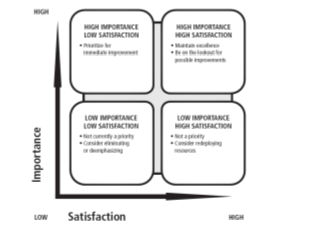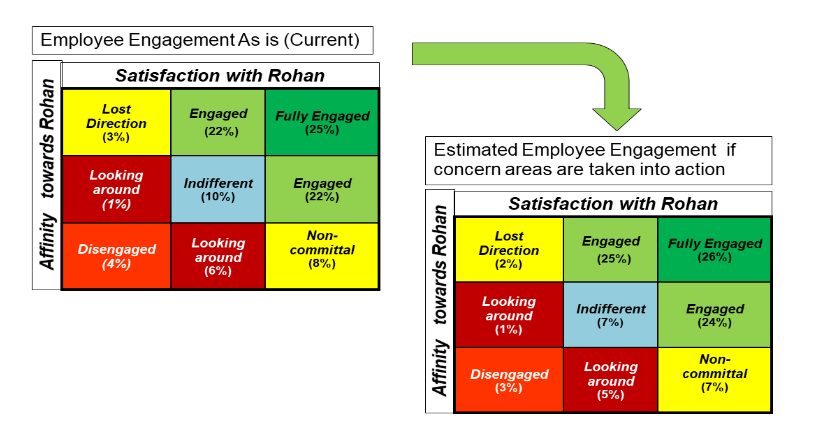Employee
Satisfaction
WHAT IS EMPLOYEE SATISFACTION?
o Employee satisfaction is typically measured using an employee satisfaction survey to analyze the liking and approval of a particular group of stakeholders for its services, work environment, culture, or employment. Factors that influence employee satisfaction addressed in these surveys might include compensation, workload, perceptions of management, career growth opportunities, rewards and recognition at work, flexibility, teamwork, resources, etc.
o In simple words Employee satisfaction is the extent to which employees are happy or content with their jobs and work environment.
o It’s important to collect employee satisfaction feedback because engaged employees are great for business as,
1. They are more productive and take fewer days off
2. They stay with the company longer
3. They improve the customer experience
4. They become advocates for the company
HOW IS IT MEASURED?
Employee satisfaction can be measured 2 ways:
1. Indirectly, by watching trends in employee turnover
o In indirect measurement, management watches the trends in employees leaving the organization, and assumes that satisfaction levels are adequate when turnover levels are at or below industry norms.
o They also watch for specific departments or functions with higher-than-average or higher-than-usual turnover, and implement direct measurement actions in those areas to determine causes for the increase in separations
2. Directly, by asking employees about their level of satisfaction via surveys, interviews, and focus groups.
o Direct measurement methods involve asking employees about their level of satisfaction, by sending an anonymous survey through mail to all employees asking for their level of satisfaction with different aspects of their jobs.
o Interviews, focus groups and Surveys might also be conducted, to understand the employee engagement.
Questions asked might include:
o Are they satisfied with their specific jobs and their tasks?
o Do they feel that they have the support and resources they need to do their best work?
o Is management providing appropriate direction?
o Do they think compensation, benefits, and work conditions are adequate?
HOW EMPLOYEE SATISFACTION AFFECTS CUSTOMER SATISFACTION?
o There’s a direct link between employee satisfaction and customer satisfaction. Happy employees create satisfied and happy customers. Unhappy employees lead to unhappy customers. Employees are the driving factor behind customer satisfaction.
o Employee interactions leads to positive or negative customer experience. When employees aren’t happy at work, their productivity is affected which indirectly affects the growth of the organization. This plays a critical role in businesses where employees are directly interacting with customers, such as FMCG and Retail.
o Organizations need to begin investing a similar energy into dealing with their employees as they do dealing with their clients.
o Perhaps the easiest way to improve employee experience is to request and welcome their input and feedback. They have great insight into customer needs. As they are the ones who are directly interact with clients and hearing their reactions and praises.
o Showing employees that you value the work they’re doing is one of the easiest ways to boost their motivation. Employees need to understand how important their role is and how their work fits into the bigger picture. They have to feel like their voices are being heard and they have regard from their administrators/managers.
WAYS TO IMPROVE EMPLOYEE SATISFACTION.
1. Individuals should be assigned work as per their expertise, interest area and specialization.
2. No employee should be overburdened. Work has to be equally distributed among all.
3. Encourage employees to talk to each other, discuss among themselves and work as a single unit not for themselves but for the organization.
4. Give ample growth opportunities to employees.
5. Nothing works better than rewarding employees suitably and releasing their salaries on time.
Types of Employee Surveys
Organisations conduct surveys among employees for a variety of reasons. Some of the more commonly run surveys with employees are
1. Pulse Surveys
It is a fast and frequent survey system, that does away with complex questions and is intentionally designed to be done weekly, or every few weeks. They give a quick insight into the health of a company, hence the name ‘pulse’.
2. Employee Attitude Surveys.
It helps in Assessing employees’ emotions and feelings within the workplace.
3. Employee Opinion Surveys.
It helps in Discovering views and beliefs held by employees.
4. Employee Satisfaction Surveys.
It determines the root cause of dissatisfaction issues, and target them accordingly.
5. Employee Engagement Surveys.
It measures how engaged, eager, and dedicated employees are with respect to their job, co-workers, management, and the company.
6. 360 Surveys.
It examines the employee from multiple viewpoints, including co-workers, supervisors, managers, subordinates, vendors, and customers.
7. Organizational Assessment Surveys.
It measures the key strengths in a company, from a global perspective.
8. Employee Exit Surveys.
It helps in providing valuable insight into workplace relationships, training, opportunities for growth, and work processes within an organization.
9. Professional Development Surveys.
Asks the employees if they feel they’ve been given the proper training and development tools to advance their professional career goals in the workplace.
Market Search India Private Limited Engagement Model:
Employee engagement means “Understanding the Emotional Connect of the employees with the organization along with the satisfaction level is critical to achieve Business Goals”
1) How it is measured?
1. Affinity – Emotional attachment that gives a sense of belonging with the organization which is based on their belief that they will be able to achieve their personal goals in this organization
2. Satisfaction levels which is more transactional attachment with the organization
Combination of the above two factors are essential to ensure that employees are engaged and contribute to organizations success.
What does this analysis provide?

Engagement Matrix – this will help us in segregating current employees in 3*3 matrix from ‘Fully engaged’ to ‘Disengaged’.

Parameters which are of high importance and showing lower satisfaction shows the areas of concern for improvement
3). Scenario building – This is an advance analysis to help organization make the most from the survey.
a. Decide on which initiatives to start and which to prioritize in order to improve engagement
b. Uncover opportunities for synergy effects when multiple changes are made simultaneously.
c. Understand the effect of chosen initiatives.
d. Optimize the budget by focusing on the initiatives which has high impact on the engagement drivers

